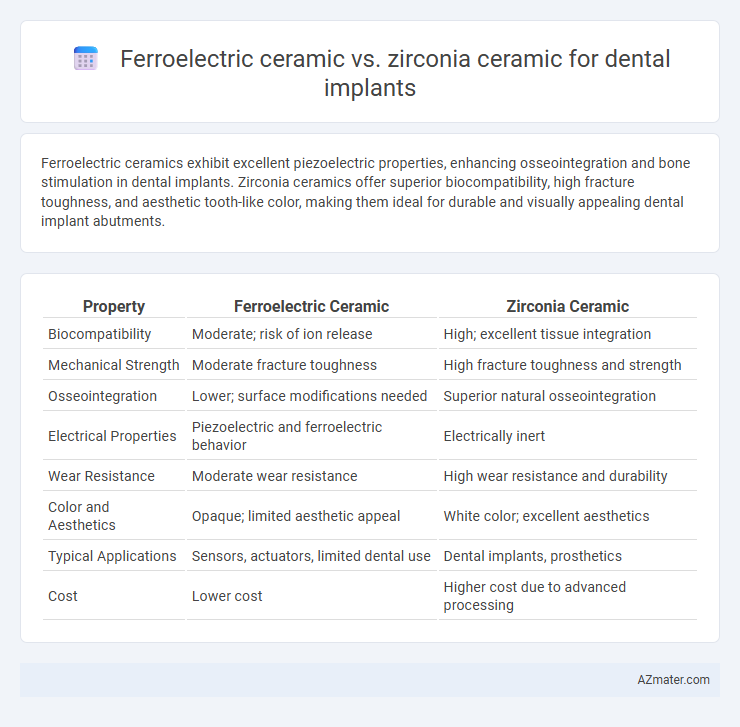Ferroelectric ceramics exhibit excellent piezoelectric properties, enhancing osseointegration and bone stimulation in dental implants. Zirconia ceramics offer superior biocompatibility, high fracture toughness, and aesthetic tooth-like color, making them ideal for durable and visually appealing dental implant abutments.
Table of Comparison
| Property | Ferroelectric Ceramic | Zirconia Ceramic |
|---|---|---|
| Biocompatibility | Moderate; risk of ion release | High; excellent tissue integration |
| Mechanical Strength | Moderate fracture toughness | High fracture toughness and strength |
| Osseointegration | Lower; surface modifications needed | Superior natural osseointegration |
| Electrical Properties | Piezoelectric and ferroelectric behavior | Electrically inert |
| Wear Resistance | Moderate wear resistance | High wear resistance and durability |
| Color and Aesthetics | Opaque; limited aesthetic appeal | White color; excellent aesthetics |
| Typical Applications | Sensors, actuators, limited dental use | Dental implants, prosthetics |
| Cost | Lower cost | Higher cost due to advanced processing |
Introduction to Dental Implant Materials
Ferroelectric ceramics and zirconia ceramics represent advanced materials in dental implantology, each offering unique properties that influence osseointegration and biocompatibility. Zirconia ceramics are favored for their exceptional strength, fracture toughness, and aesthetic qualities, making them suitable for patients requiring metal-free implants. Ferroelectric ceramics, though less common, provide potential benefits in bone regeneration due to their electrical polarization properties, which may stimulate cellular activity and enhance implant integration.
Overview of Ferroelectric Ceramics in Dentistry
Ferroelectric ceramics in dentistry offer unique advantages such as high piezoelectric properties and electrical polarization, enabling enhanced osseointegration and improved bone regeneration around dental implants. Unlike zirconia ceramics, which are primarily valued for their exceptional mechanical strength and biocompatibility, ferroelectric ceramics provide active electrical stimuli that can accelerate tissue healing and promote better implant stability. Research highlights the potential of ferroelectric materials like barium titanate for developing smart dental implants with self-sensing and therapeutic functions.
Zirconia Ceramics: Properties and Applications
Zirconia ceramics exhibit exceptional biocompatibility, high fracture toughness, and excellent wear resistance, making them ideal for dental implants. Their low thermal conductivity and corrosion resistance enhance durability and patient comfort, while the tooth-like color ensures superior aesthetics compared to traditional metal implants. These properties contribute to zirconia's widespread application in dental crowns, bridges, and implant abutments, offering a metal-free alternative with reduced risk of allergic reactions and improved osseointegration.
Mechanical Strength Comparison
Ferroelectric ceramics exhibit moderate mechanical strength with high piezoelectric properties, but zirconia ceramics outperform them in terms of fracture toughness and flexural strength, making zirconia more suitable for dental implants subjected to high masticatory forces. Zirconia's mechanical strength typically ranges from 900 to 1200 MPa flexural strength and fracture toughness around 5-10 MPa*m^0.5, whereas ferroelectric ceramics often show lower values due to their structural composition. The superior mechanical robustness of zirconia ceramics ensures enhanced longevity and resistance to crack propagation in oral environments compared to ferroelectric ceramics.
Biocompatibility and Osseointegration
Ferroelectric ceramics exhibit strong piezoelectric properties that can enhance cell proliferation and differentiation, promoting superior osseointegration and favorable biocompatibility in dental implants. Zirconia ceramics are highly biocompatible, exhibiting excellent corrosion resistance and minimal inflammatory response, making them a popular metal-free alternative with reliable osseointegration. Comparative studies indicate that while zirconia ensures stable bone-implant integration, ferroelectric ceramics potentially improve healing rates due to their electroactive surface properties.
Aesthetic Considerations in Implant Selection
Ferroelectric ceramics offer unique polarization properties but show limited aesthetic advantages compared to zirconia ceramics in dental implants. Zirconia ceramic implants provide superior translucency and color matching to natural teeth, enhancing the visual integration in the anterior region. The white, tooth-like appearance of zirconia reduces the risk of metallic grayish hues seen with some implant materials, making it preferable for patients prioritizing aesthetic outcomes.
Resistance to Wear and Corrosion
Ferroelectric ceramics exhibit lower resistance to wear and corrosion compared to zirconia ceramics, which offer exceptional durability in the oral environment due to their high fracture toughness and chemical stability. Zirconia ceramic implants demonstrate superior wear resistance against mechanical forces and maintain corrosion resistance in saliva, contributing to longer implant lifespan. The bioinert nature of zirconia reduces the risk of ion release and surface degradation, making it more suitable for dental applications requiring long-term performance.
Long-term Clinical Performance
Ferroelectric ceramic dental implants exhibit superior piezoelectric properties that may enhance osseointegration and bone remodeling over time, potentially improving long-term clinical performance compared to zirconia ceramics. Zirconia ceramics are highly valued for their exceptional biocompatibility and mechanical strength, offering stable clinical outcomes with low rates of peri-implant inflammation and fracture over extended follow-up periods. Longitudinal studies indicate that while both materials provide reliable durability, zirconia ceramics demonstrate more predictable performance in load-bearing applications due to their higher fracture toughness and established success rates in clinical practice.
Cost-effectiveness and Availability
Ferroelectric ceramics offer promising biocompatibility and piezoelectric properties for dental implants but are generally less cost-effective due to higher production costs and limited commercial availability. Zirconia ceramics are widely available and more cost-effective, benefiting from established manufacturing processes and broad market adoption. The balance of durability and affordability often makes zirconia the preferred choice for dental implant applications.
Future Trends in Dental Implant Ceramics
Future trends in dental implant ceramics emphasize the integration of ferroelectric ceramics due to their superior piezoelectric properties, which enhance osseointegration and tissue regeneration. Zirconia ceramics remain popular for their biocompatibility, fracture toughness, and aesthetic resemblance to natural teeth but face challenges in long-term durability under dynamic oral conditions. Emerging research focuses on hybrid composites combining ferroelectric and zirconia ceramics to optimize mechanical strength, biological response, and functional longevity in next-generation dental implants.

Infographic: Ferroelectric ceramic vs Zirconia ceramic for Dental implant
 azmater.com
azmater.com